BMW i7 xDrive60[1]: Energy consumption, combined WLTP in kWh/100 km: 19.6–18.5; Electric range, WLTP in km: 589–624
THE CURRENT BMW 7 SERIES.
The uncompromising combination of sportiness, driving dynamics, luxury and comfort is what makes the BMW 7 Series so unique. With these premium class vehicles, BMW has been defending its leading position in the luxury saloon segment for decades now. Discover sophisticated supremacy, exclusive materials and style-conscious design.
- 650 kw (PS)
- 0–100 in 3.7 Sek
BMW i7 M70 xDrive Sedan.
BMW i7 M70 xDrive[1]: Energy consumption, combined WLTP in kWh/100 km: 23.7–20.8; Electric range, WLTP in km: 490–559
- 530 hp
- 0–100 in 4.7 Sec
BMW X7 M60i xDrive.
BMW X7 M60i xDrive[1]: Fuel consumption, combined WLTP in l/100 km: 12.9–12.1; CO2 emissions, combined WLTP in g/km: 292–273
- bis zu 375 kw (PS)
- 0–100 ab 5.8 Sek
BMW X7.
- 420 kw (PS)
- 0–100 in 4.3 Sek
BMW M760e xDrive Sedan.
BMW M760e xDrive[1][2][3][4]: Fuel consumption, combined WLTP in l/100 km: 1.4–1.1; CO2 emissions, combined WLTP in g/km: 31–25; Energy consumption, combined WLTP in kWh/100 km: 26.0–23.4; Electric range, WLTP in km: 70–78
- 220 kw (PS)
- 0–100 in 5.8 Sek
BMW 740d xDrive Sedan.
BMW 740d xDrive(5): Fuel consumption, combined WLTP in l/100 km: 6.8-6.1; CO2 emissions, combined WLTP in g/km: 179-160
FURTHER TOPICS.

BMW ELECTROMOBILITY.
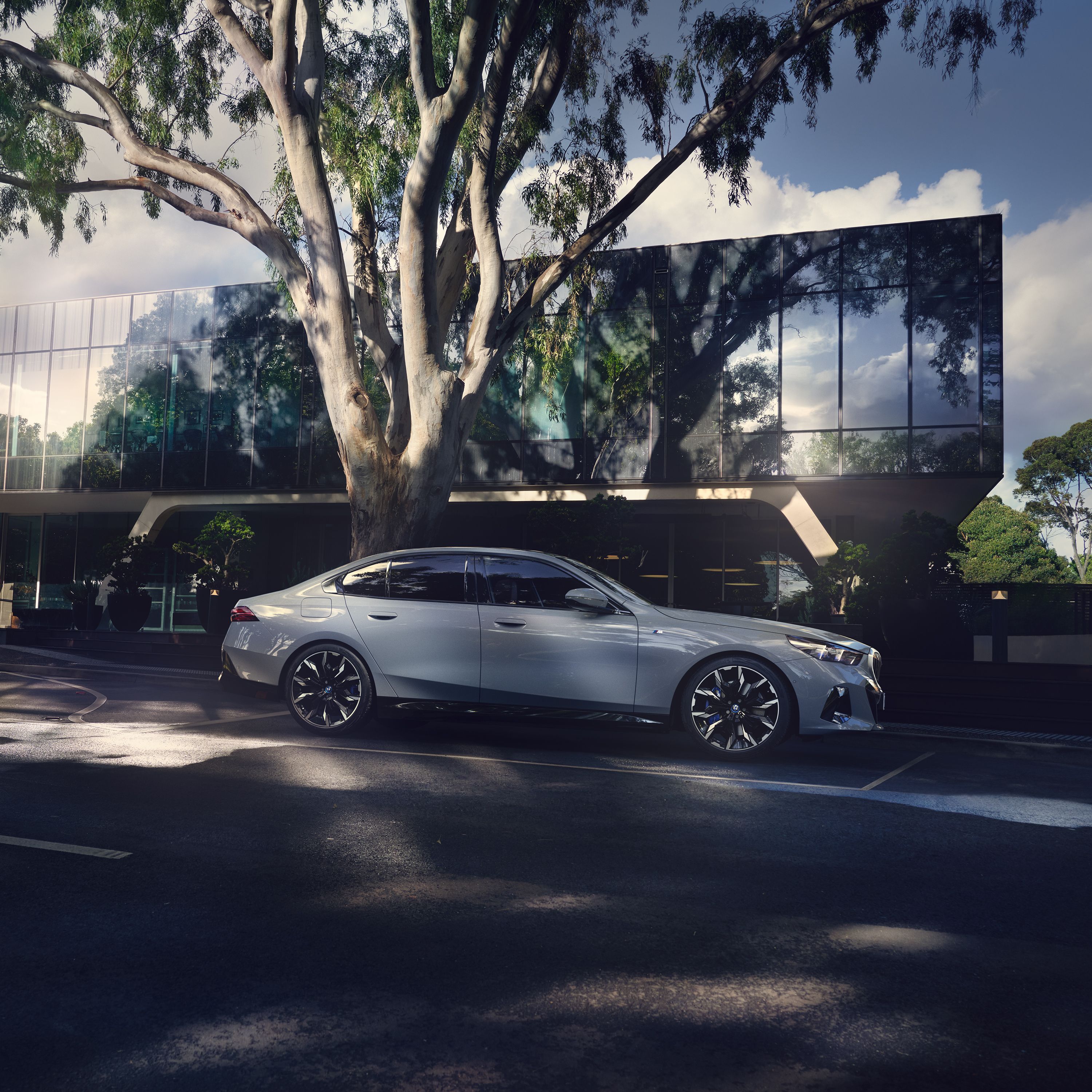
BMW FINANCIAL SERVICES.
OVERVIEW OF THE BMW 7 SERIES.
The BMW 7 Series represents technological innovation in the premium segment ever since its first generation. It sets the standard in travel comfort, driving dynamics and safety with every iteration. Even the very first BMW 7 Series is available with automatic air conditioning, cruise control, and an anti-lock braking system. As a real pioneer, the BMW 7 Series introduces even features such as Xenon lights and a navigation system as a standard feature. Being optimized for performance, the engine options of the BMW 7 Series are convincing in every aspect. In this way, the luxury sedan ensures a presence that will be remembered.
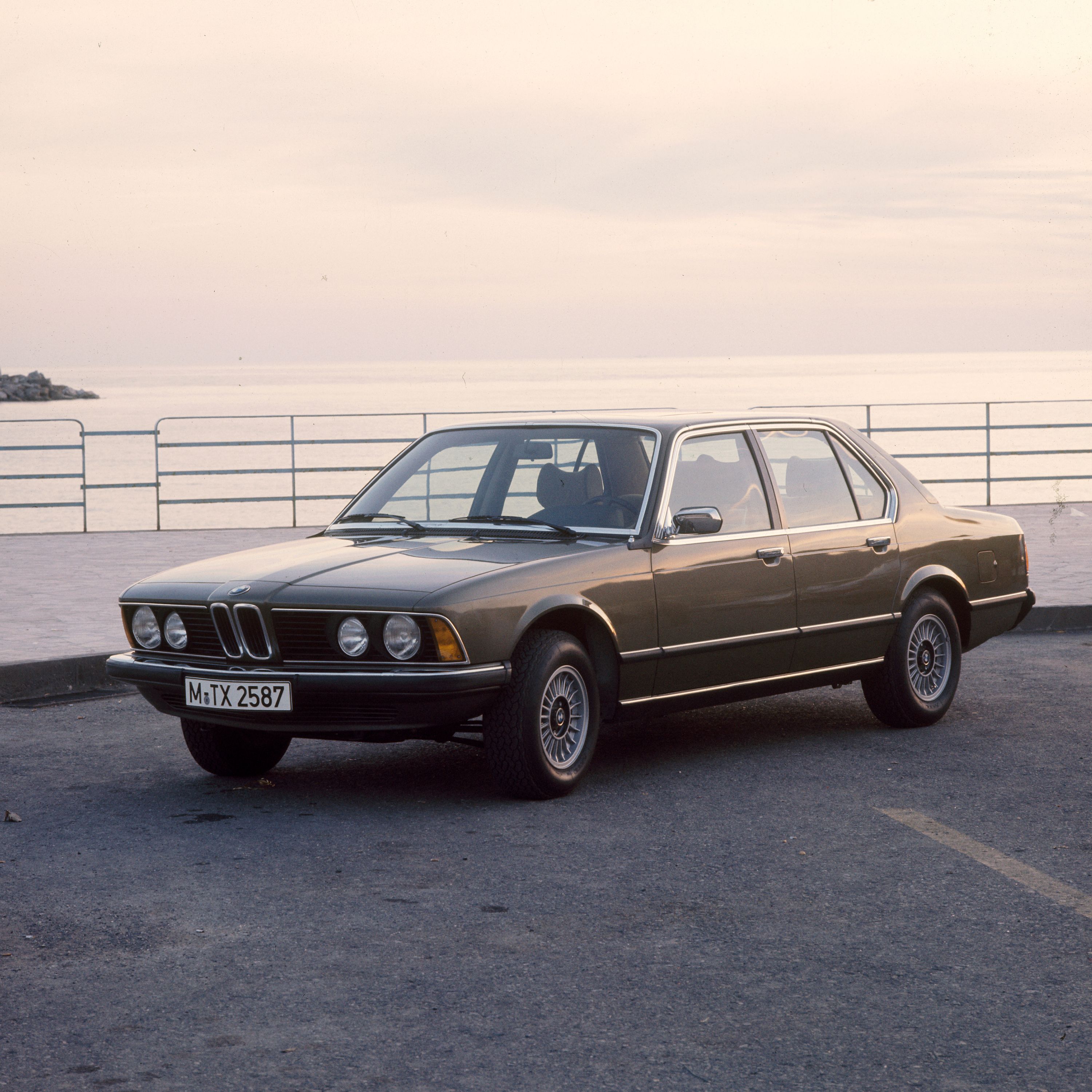
THE FIRST GENERATION (E23).
The BMW 7 Series is first introduced in 1977. A vehicle intended to embody sportiness, technical innovation and luxury at the highest level. As the successor to the BMW E3 model series, it features a six-cylinder engine. The engine demonstrates its superiority at every power level with incomparable smoothness and performance, making the vehicle the sportiest saloon in the luxury car segment. The body's design is based on a draft by Paul Bracq. The sloping front and rear sections and low waistline emphasise the sporty character of the luxury saloons.
As early as 1978, there is modern equipment available for the model, such as electronic automatic air conditioning and cruise control. From 1979 onwards, an anti-lock braking system (ABS) and digital engine electronics are also available. In the same year, all engines switch to petrol injection.
The BMW 745i is introduced in 1980 as the top model. It has a power output of 252 hp and reaches a maximum speed of 227 km/h. The 1982 model update sees the front take on an even more dynamic appearance. The BMW 7 Series is also updated to include a four-speed automatic transmission and a revised chassis and suspension system. In the space of nine years, over 270,000 vehicles from the most successful series roll off the production lines. They help BMW to maintain its leading position in the modern luxury saloon segment.
Production period: 1977–1986
Engines: 2.5–3.4 litres (150–252 hp), 6-cylinder
Length/breadth/height: 4,860 mm/1,800 mm/1,430 mm.
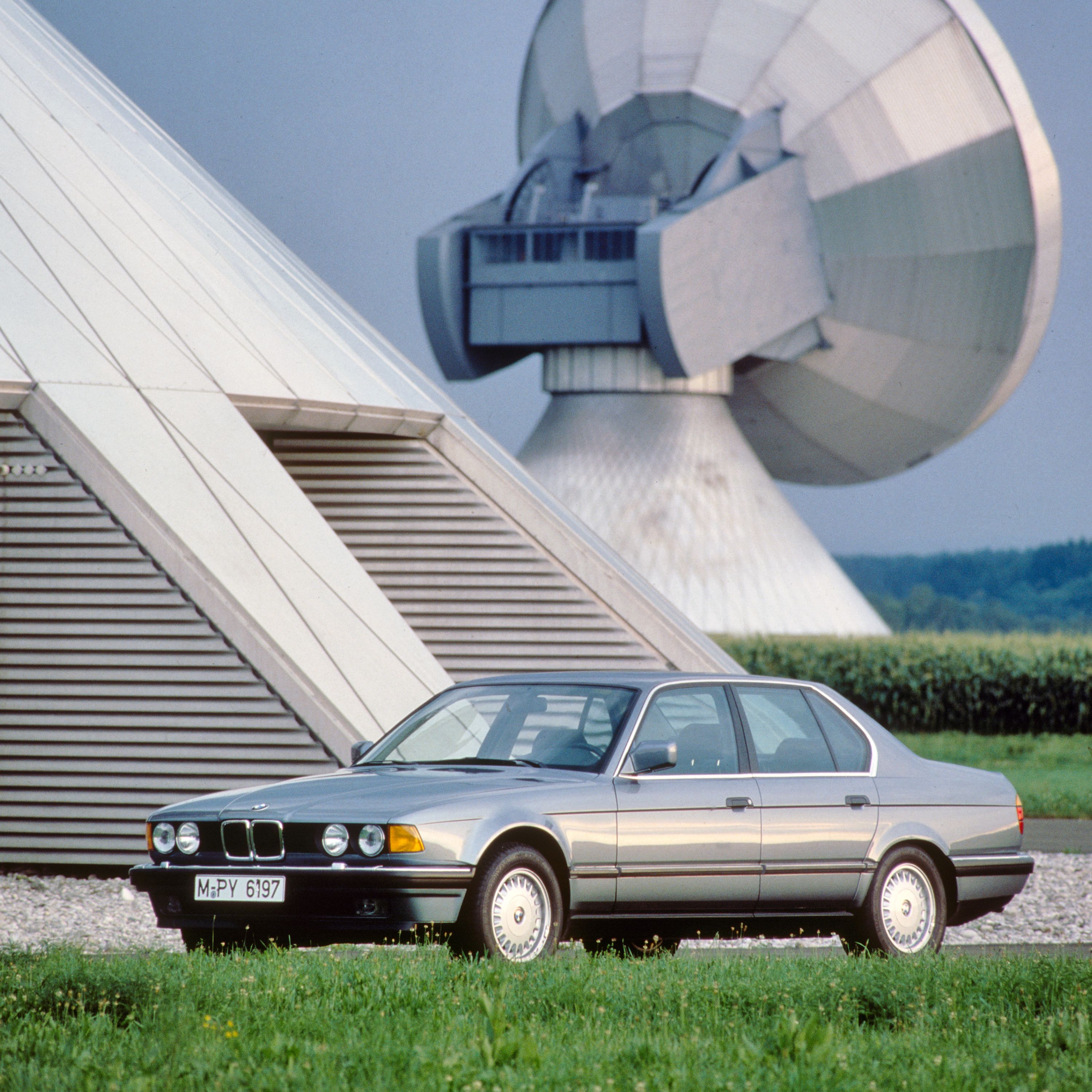
THE SECOND GENERATION (E32).
The design of the BMW 7 Series is updated for the second generation under the leadership of Claus Luthe. It is characterised by harmonious lines and dynamic, confident style elements. These include the wide kidney-shaped radiator grille in the front and the L-shaped lights on the impressive rear. The vehicle features ABS as standard. Park Distance Control is also available on request, as well as double glazing for considerably less noise in the vehicle interior and mist-free windows.
From 1987 onwards, the luxury saloon is available with a 5.0-litre V12 engine. Delivering 300 hp of power, this engine is the first of its kind to be seen in the post-1945 German automotive manufacturing industry. The model is also available as a long version for optimal comfort. With its exclusive equipment, such as an on-board fridge and in-car telephone, the new High Line equipment range takes luxury to a new level in 1989.
Xenon lights are also available as optional equipment for the first time in a production vehicle from 1991 onwards. With the major model update a year later, two 8-cylinder engines with three and four litres of displacement round out the portfolio of available engines. By 1994, around 310,000 vehicles have been produced.
Production period: 1986–1994
Engines: 3.0–5.0 litres (184–300 hp), 6, 8 and 12-cylinder
Length/breadth/height: 4,910–5,024 mm/1,845 mm/1,400–1,411 mm
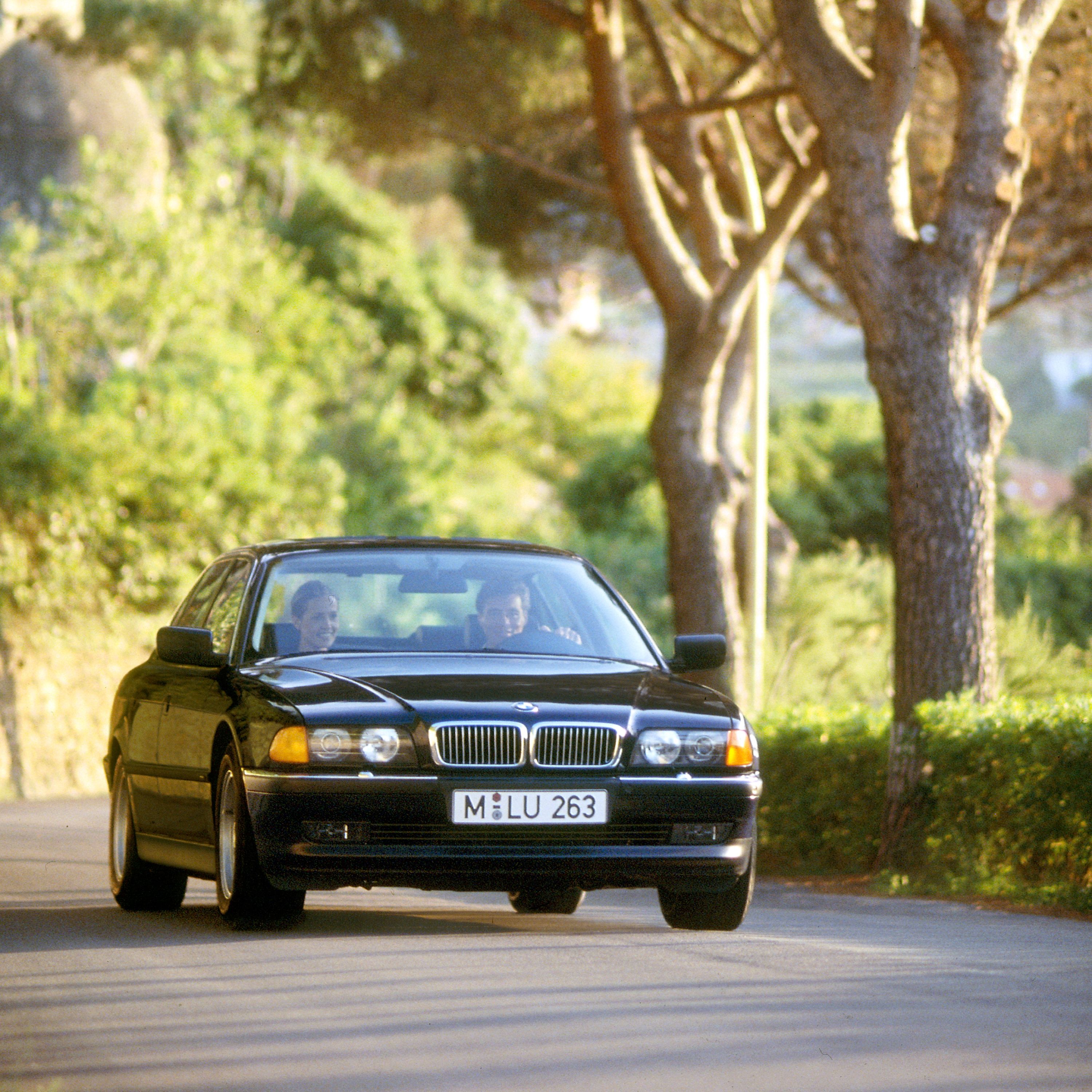
THE THIRD GENERATION (E38).
The new generation of the BMW 7 Series hits the showrooms in 1994. It wins drivers over with technical innovations and is the first ever vehicle in Europe to be equipped with a navigation system. From 1997 on, side airbags for the driver and front passenger become part of the standard equipment, and a year later, head airbags are installed to protect the passengers. The design becomes broader and sportier, but also more elegant.
It is the first BMW 7 Series with the option of a diesel engine which, with 3.0 litres and 6 cylinders, generates 184 hp using common rail technology. From 1996 onwards, a 6-cylinder diesel engine with 2.5-litre displacement and 143 hp completes the lower end of the diesel engine range. With a V8 diesel engine and output of 245 hp, the luxury saloon vehicle sets new records in 1999. This makes the model the most powerful diesel car to date.
In terms of performance, the BMW 750i/750iL is the most powerful model. With 12 cylinders and 5.4-litre displacement, the engine generates 326 hp of power. The model update in 1998 sees a new design with more dynamic headlights and rear lights. It also has redesigned side sills and a somewhat wider radiator grille. The range of engines available is also revised, meaning that they become more efficient while offering a higher level of performance. From 2000 onwards, the BMW 7 Series also features new engine technology: the BMW 750hL is produced in smaller quantities and uses hydrogen as fuel. In addition to the regular long version, around 900 vehicles are produced with the L7 designation. They are 39 centimetres longer than the basic version. In total, approximately 327,000 of these BMW 7 Series models are manufactured.
Production period: 1994–2001
Engines: 2.5–5.4 litres (143–326 hp), 6, 8 and 12-cylinder
Length/breadth/height: 4,984–5,374 mm/1,862 mm/1,425–1,435 mm
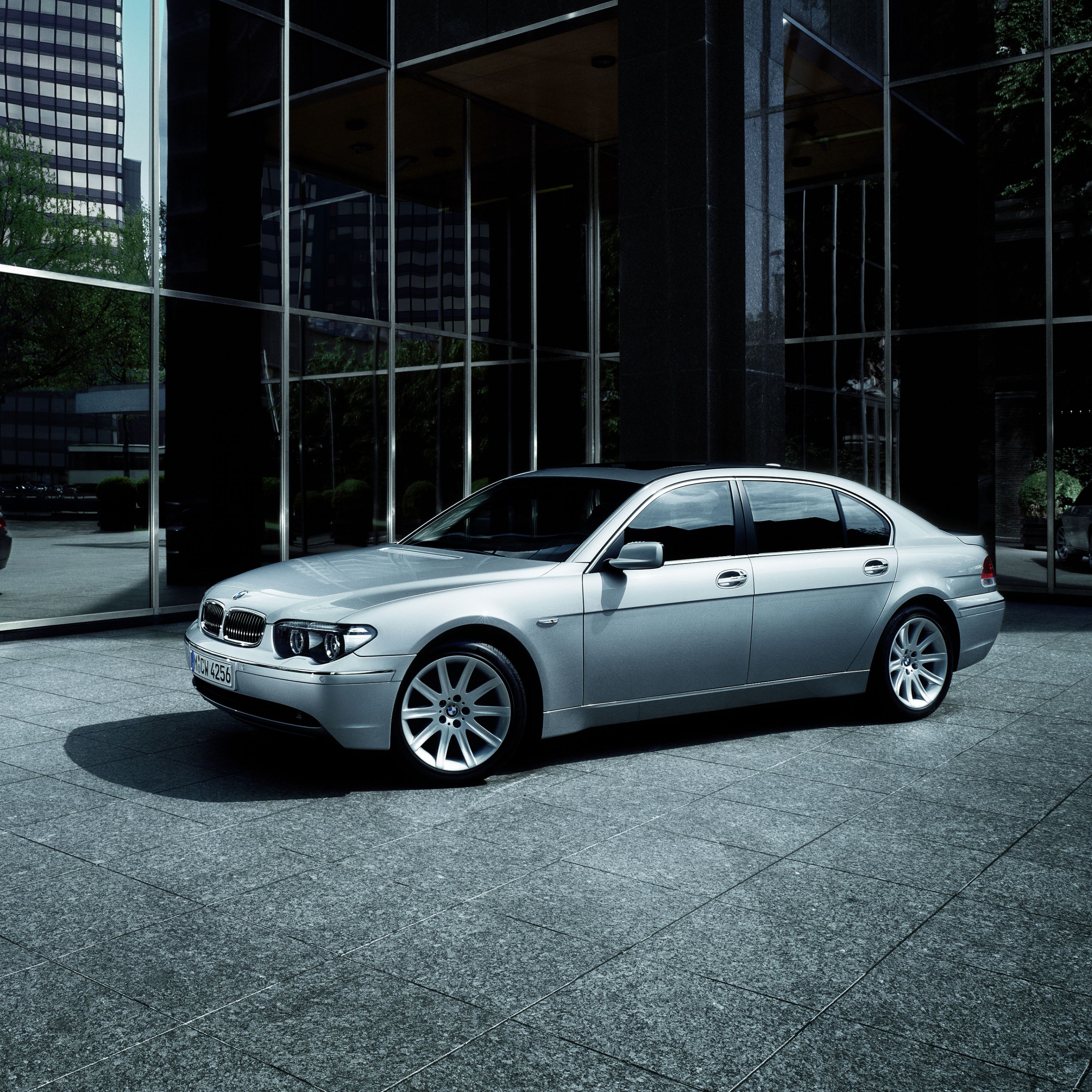
THE FOURTH GENERATION (E65, E67, and E68).
In 2001, the new BMW 7 Series is presented as an entirely new vehicle. Chris Bangle and his team are responsible for the design. This features completely redesigned headlights combined with a characteristically offset tailgate. In the interior, drivers can experience an operating concept that has never been seen before, with the iDrive system. The number of controls are therefore reduced. Drivers can now access the approximately 700 functions of the comprehensive vehicle systems using a single button. This button can be rotated, moved in eight different directions, and pressed. The on-board computer also has access to the internet. The six-speed automatic transmission with a selector lever on the steering wheel is a world first. The top-of-the-range engine has an output of 445 hp, generated by 12 cylinders with six-litre displacement.
From 2003 onwards, the BMW 7 Series is available with Adaptive Headlights. The major model update follows two years later. In terms of the aesthetics, the rear becomes broader and the radiator grille is made larger. Bi‐xenon headlights in an even more dynamic design become part of the standard equipment. The iDrive system is enhanced and operation becomes even more efficient. The same year also sees the introduction of the High-beam Assistant and BMW Night Vision, the latter offering increased safety in the dark.
The various type designations are used to describe the following vehicle versions: The Saloon (E65), the long version with 14-centimetre longer wheelbase (E66), a special armoured version (E67), and a version with hydrogen drive (E68).
Production period: 2001–2008
Engines: 3.0–6.0 litres (218–445 hp), 6, 8 and 12-cylinder
Length/breadth/height: 5,039–5,179 mm/1,902 mm/1,491 mm
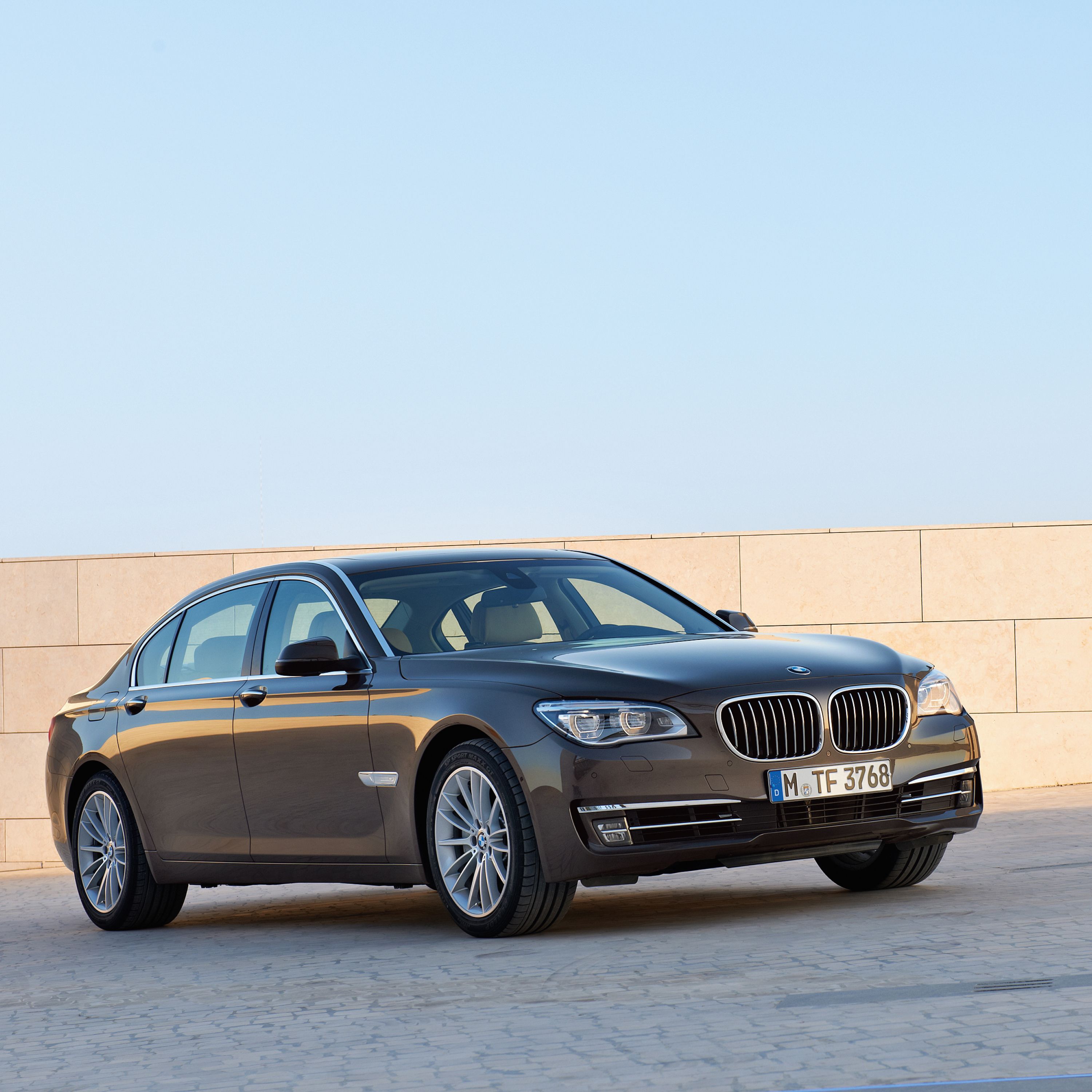
THE FIFTH GENERATION (F01-F02).
Confident driving dynamics. An outstanding presence. Extraordinary comfort. At its launch in Munich, the BMW 7 Series shows how it is defining new standards for these qualities. The design is as elegant as it is sporty. This is thanks to the long bonnet, low roof line and dynamic proportions. A chrome strip runs across the entire rear. Together with the rear lights, it emphasises the width of the vehicle.
The vehicle interior features exclusive, high-quality materials, as well as a plethora of modern driver assistance systems. These systems range from the adaptive cruise control to the Lane Keeping Assistant, to the BMW head-up display. For additional safety, there are also cameras which display the view to the rear, and even a Surround View. This function generates an image of the vehicle from a top-down perspective, providing the best possible overview of the situation.
A sporty performance is assured by the range of diesel and petrol engines on offer. These extend from twin turbocharged engines right up to the BMW 760i, which has a high-performance V12 engine with an output of 544 hp. The BMW 7 Series is also available with a hybrid drive system for the first time. The optional all-wheel drive, the Adaptive Drive roll stabilisation and the Electronic Damper Control (EDC) contribute to the typical BMW driving dynamics. They allow for safer and more precise driving.
The model update in 2012 sees the introduction of a new central display with 3D look, updated assistance systems like the LED High-beam Assistant, and revised engines offering greater efficiency.
Production period: 2008–2015
Engines: 3.0–6.0 litres (245–544 hp), 6, 8 and 12-cylinder
Length/breadth/height: 5,072–5,212 mm/1,902 mm/1,479 mm
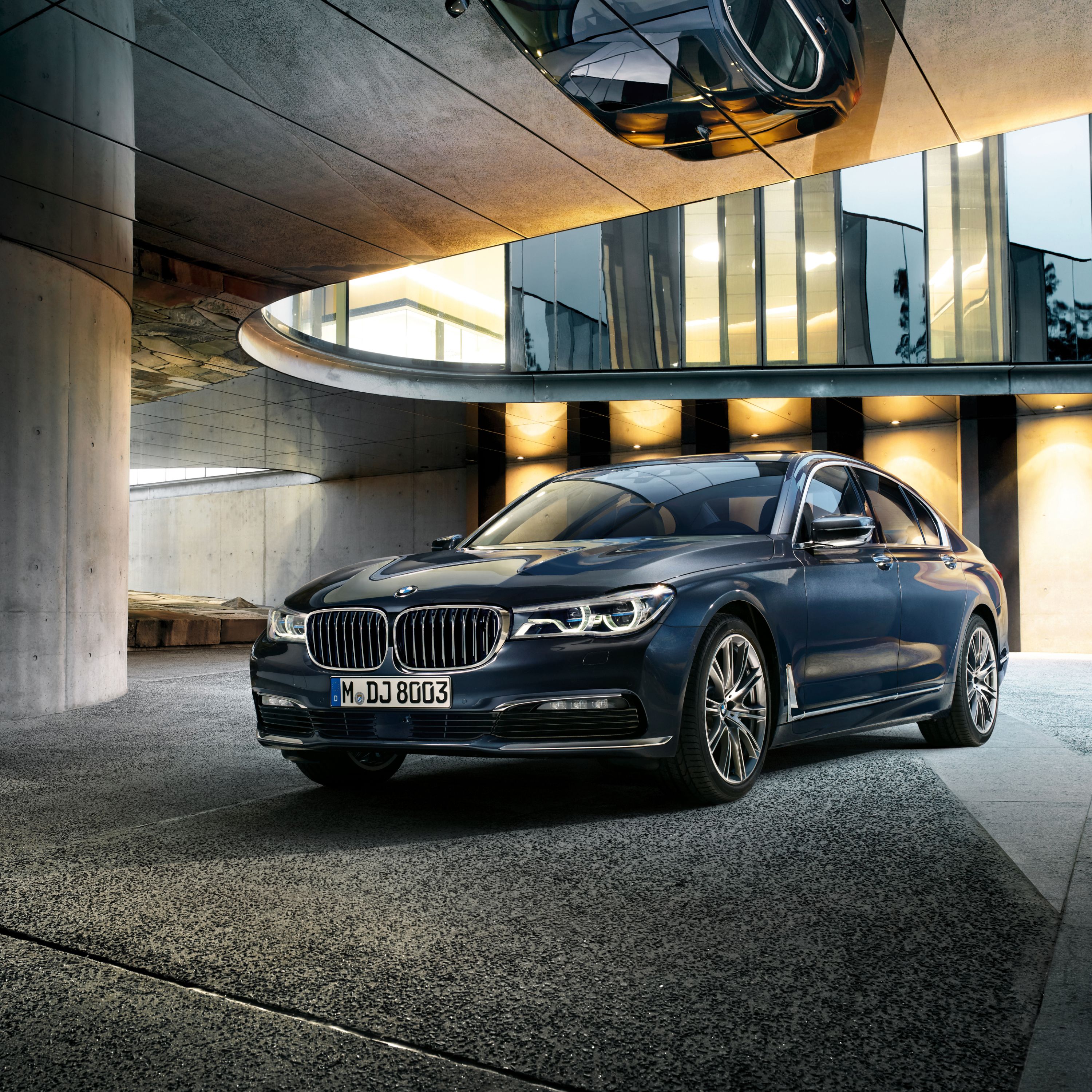
THE SIXTH GENERATION (G11, G12).
The BMW 7 Series (G11), produced from 2015 onwards, combines intelligent dynamics and precision with an extraordinary presence and exclusive luxury. This is already evident from the elaborate paintwork with iridescent effects. But also from the striking design of the rear. As of 2019, the flat LED lights are connected to one another by a slim light strip. In conjunction with the trapezoidal exhaust tailpipes positioned further towards the side, they create a particularly confident aesthetic. The body is made of a combination of CFRP (carbon-fibre-reinforced plastic), steel and aluminium. This results in a considerable weight reduction. The long version (G12) is available with a panoramic glass sunroof, which provides ample ventilation thanks to its sliding and tilting functions. The Sky Lounge feature also offers colourful graphics. They harmonise perfectly with the accent lighting on the B-pillar. When you approach the BMW 7 Series, it greets you with “Welcome” lighting effects.
The vehicle interior has a particularly individualised aesthetic thanks to use of exclusive high-quality materials, such as the Nappa leather trim with “Cognac” quilting, the adaptable interior trim and the headliner. The rear-seat entertainment system captivates passengers with an HD touchscreen. In the Executive Lounge version, the passengers in the rear are able to enjoy the highest level of comfort thanks to the luxurious seats. These are equipped with massage functions offering a multitude of settings. On the rear passenger side, the occupant experiences a perfect all-round view, and the footrest is attached to the front passenger seat.
Thanks to the integrated SIM card, the BMW Personal Assistant has unrestricted mobile access to apps and services. For example, the consistently updated Connected Navigation service and the option to perform Remote Software Upgrades. Thanks to BMW Connected, the vehicle stays connected to a smartphone at all times. The partially automated driving feature for leaving parking spaces allows drivers to control the vehicle remotely. This means that the BMW 7 Series can drive itself out of garages under the driver’s supervision.
The design of the 2019 model update further emphasises the presence and width of the luxury saloon. This is achieved by way of the significantly larger radiator grille and the adapted headlights.
Production period: 2015–2022
Engines: 2.0–6.6 litres (249–610 hp), 4, 6, 8 and 12-cylinder
Length/breadth/height: 5,098–5,260 mm/1,902 mm/1,467–1,479 mm
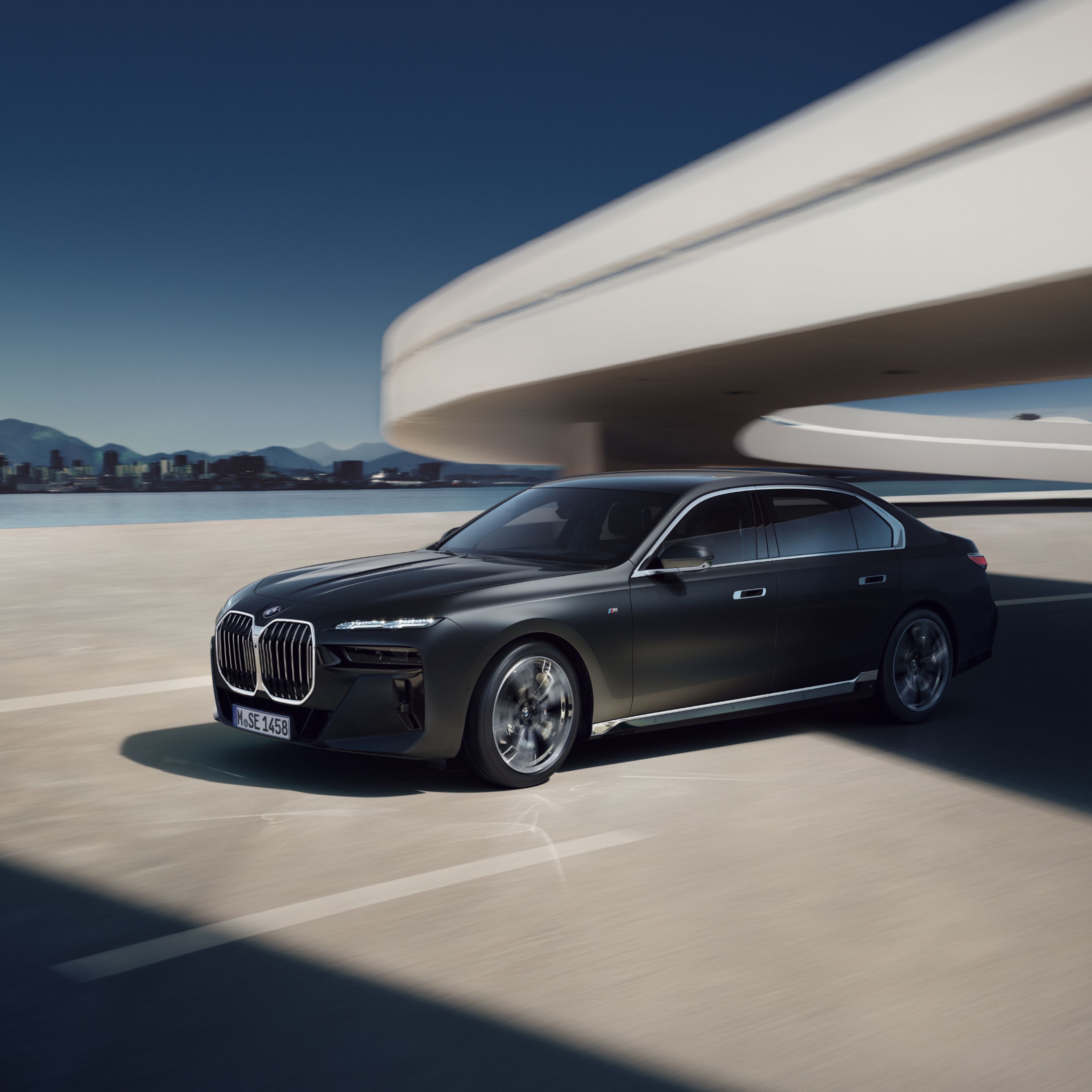
THE SEVENTH GENERATION (G70).
The launch of the new BMW 7 Series in 2022 heralds the emergence of the new face of the luxury class. It combines pure elegance with outstanding driving characteristics, and offers unique entertainment for all of the senses.
The iconic front and a monolithic design language mean that this model is a true head-turner. Thanks to the contour lighting on the radiator grille and the two-part, slim LED headlights, the vehicle has a particularly elegant aesthetic. Upon request, an even more sophisticated headlight design is available, with the BMW crystal Iconic Glow with backlit Swarovski elements. In conjunction with the impressive lighting effects of the “Great Entrance Moments” welcome scenario, this creates an image of an outstanding and exclusive personality.
The vehicle interior is characterised by the unique interplay of elegance, comfort and innovation. High-quality materials, such as Merino leather, cashmere wool and Swarovski crystals convey an air of luxury. The modern technology in the vehicle cockpit is ergonomically optimised for the driver. For example, the multifunctional operating elements of the BMW Interaction Bar sets a striking accent with its crystalline look, combining both visual and haptic controls. Together with the high-resolution, 14.9" BMW Curved Display, this creates a unique multimedia experience in the vehicle cockpit.
However, the thrill of riding in the new BMW 7 Series is not only limited to the driver. The passengers also enjoy an outstanding level of comfort. The optional 31.3" BMW Theatre Screen creates a large-scale cinematic ambience. Together with the crystal-clear sound and 4D audio of the Bowers & Wilkins Diamond Surround Sound System, the passengers in the rear are immersed in an extraordinary experience for the eyes and ears.
The luxury saloon is available with a high-performance diesel engine, as well as an efficient Plug-in Hybrid drive. Since 2022, it has also been available as a fully electric model with the pioneering BMW i7. It has an output of 544 hp and a fully electric range of more than 600 km. As such, you can enjoy sustainable and emission-free mobility in the most dynamic and flexible way possible. Composed by Hans Zimmer, the BMW IconicSounds Electric provide accompaniment for each drive mode to make the driving experience even more immersive and impressive.
Production period: Since 2022
Engines: 3.0–4.4 litres (299–659 hp), 6 and 8-cylinder; electric motor (BMW i7)
Length/breadth/height: 5,391 mm/1,950 mm/1,544 mm
FREQUENTLY ASKED QUESTIONS.
Consumption and CO2 emissions.
BMW i7 M70 xDrive[1]:
Energy consumption, combined WLTP in kWh/100 km: 23.7–20.8;
Electric range, WLTP in km: 490–559
BMW i7 xDrive60[1]:
Energy consumption, combined WLTP in kWh/100 km: 19.6–18.5;
Electric range, WLTP in km: 589–624
BMW i7 eDrive50[1]:
Energy consumption, combined WLTP in kWh/100 km: 20.3–19.1;
Electric range, WLTP in km: 575–611
BMW X7 M60i xDrive:
Fuel consumption, combined WLTP in l/100 km: 12.9–12.1;
CO2 emissions, combined WLTP in g/km: 292–273
BMW M760e xDrive[1][4]:
Fuel consumption, combined WLTP in l/100 km: 1.4–1.1;
CO2 emissions, combined WLTP in g/km: 31–25;
Energy consumption, combined WLTP in kWh/100 km: 25.9–23.4;
Electric range, WLTP in km: 71–78
BMW 760e xDrive[1][4]:
Fuel consumption, combined WLTP in l/100 km: 1.4–1.0;
CO2 emissions, combined WLTP in g/km: 31–23;
Energy consumption, combined WLTP in kWh/100 km: 26.1–23.4;
Electric range, WLTP in km: 72–80
BMW 740d xDrive:
Fuel consumption, combined WLTP in l/100 km: 6.8–6.1;
CO2 emissions, combined WLTP in g/km: 178–160
[1] Range depends on various factors, in particular: individual driving style, route characteristics, outside temperature, heating/air conditioning, pre-conditioning.
[2] Composed of combustion engine drive 381 hp and electric drive197 hp. Electric drive depending on battery charging level.
[3] For plug-in hybrid: Electric drive depending on battery charging level.
[4] For plug-in hybrid: Weighted, combined (EC AC Charge Weighted).
[5] Composed of combustion engine drive 286 hp and electric drive 18 hp.
[6] Composed of combustion engine drive 313 hp and electric drive 197 hp. Electric drive depending on battery charging level.
The figures for performance, consumption and CO2 emissions refer to vehicles with standard transmission.
Official data for fuel consumption, CO2 emissions, power consumption and electric range was determined in accordance with the prescribed measuring procedure and corresponds to European Regulation (EC) 715/2007 in the applicable version. For ranges, data determined as per WLTP takes into account any optional equipment (available on the German market in this case). For vehicles that have been newly type approved since 1 January 2021, only the official data according to WLTP exists. In addition, NEDC values are deleted from the certificates of conformity as of 1 January 2023 by EC regulation 2022/195. For more information about NEDC and WLTP measuring procedures visit www.bmw.com/wltp
Further information about fuel consumption and official model-specific CO2 emissions of new passenger cars can be found in the "Guideline for fuel consumption, CO2 emissions and electric power consumption for new passenger cars", available free of charge at all points of sale, at the Deutsche Automobil Treuhand GmbH (DAT), Hellmuth-Hirth-Str. 1, 73760 Ostfildern-Scharnhausen, Germany, and under https://www.dat.de/co2/.
Performance data of petrol engines apply to vehicles using RON 98 fuel. Fuel consumption data apply to vehicles using reference fuels in accordance with EU Regulation 715/2007. Unleaded RON 91 and higher with a maximum ethanol content of 10% (E10) may also be used. BMW recommends RON 95 fuel. For high-performance automobiles, BMW recommends RON 98 fuel.


